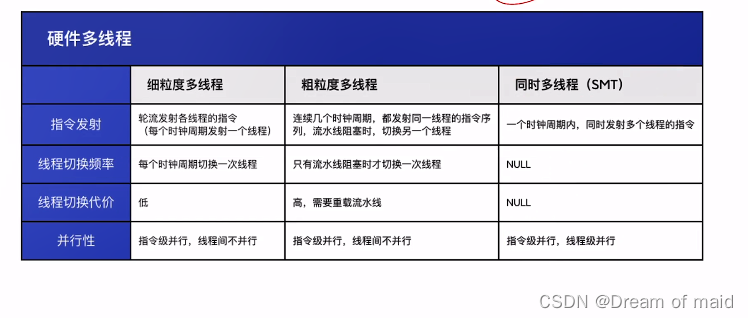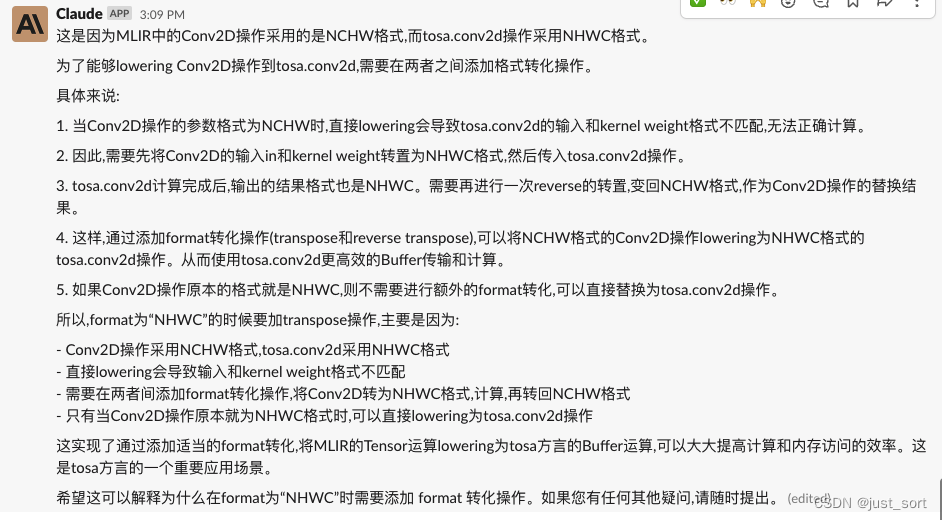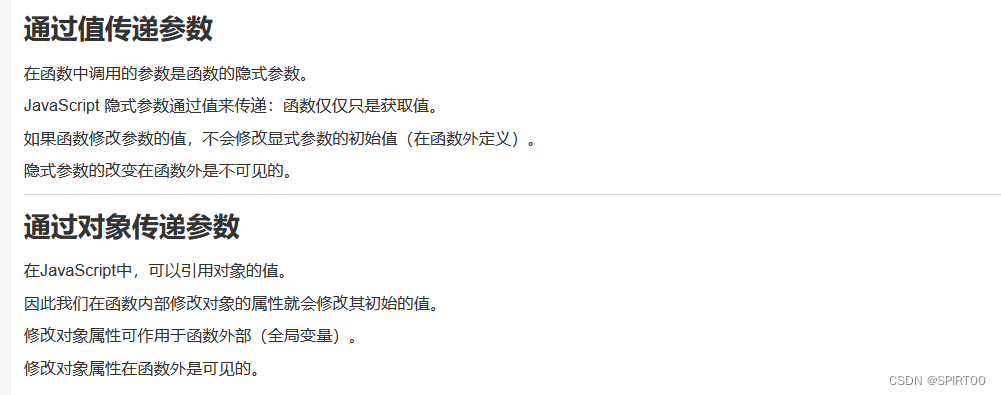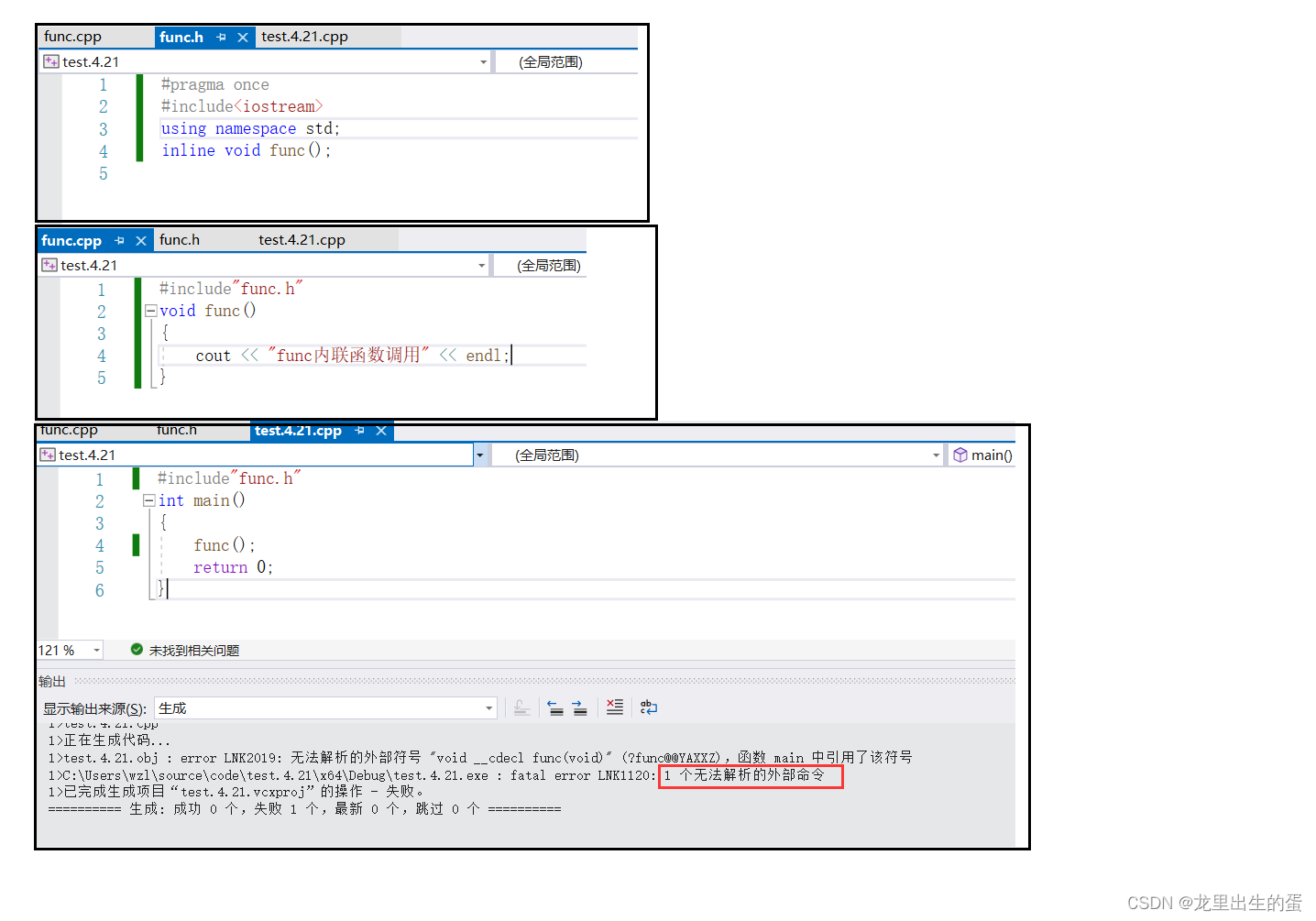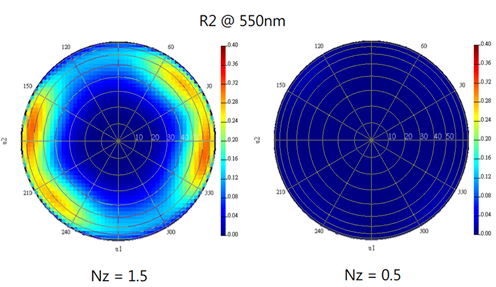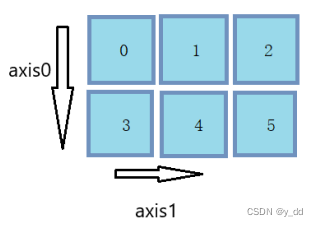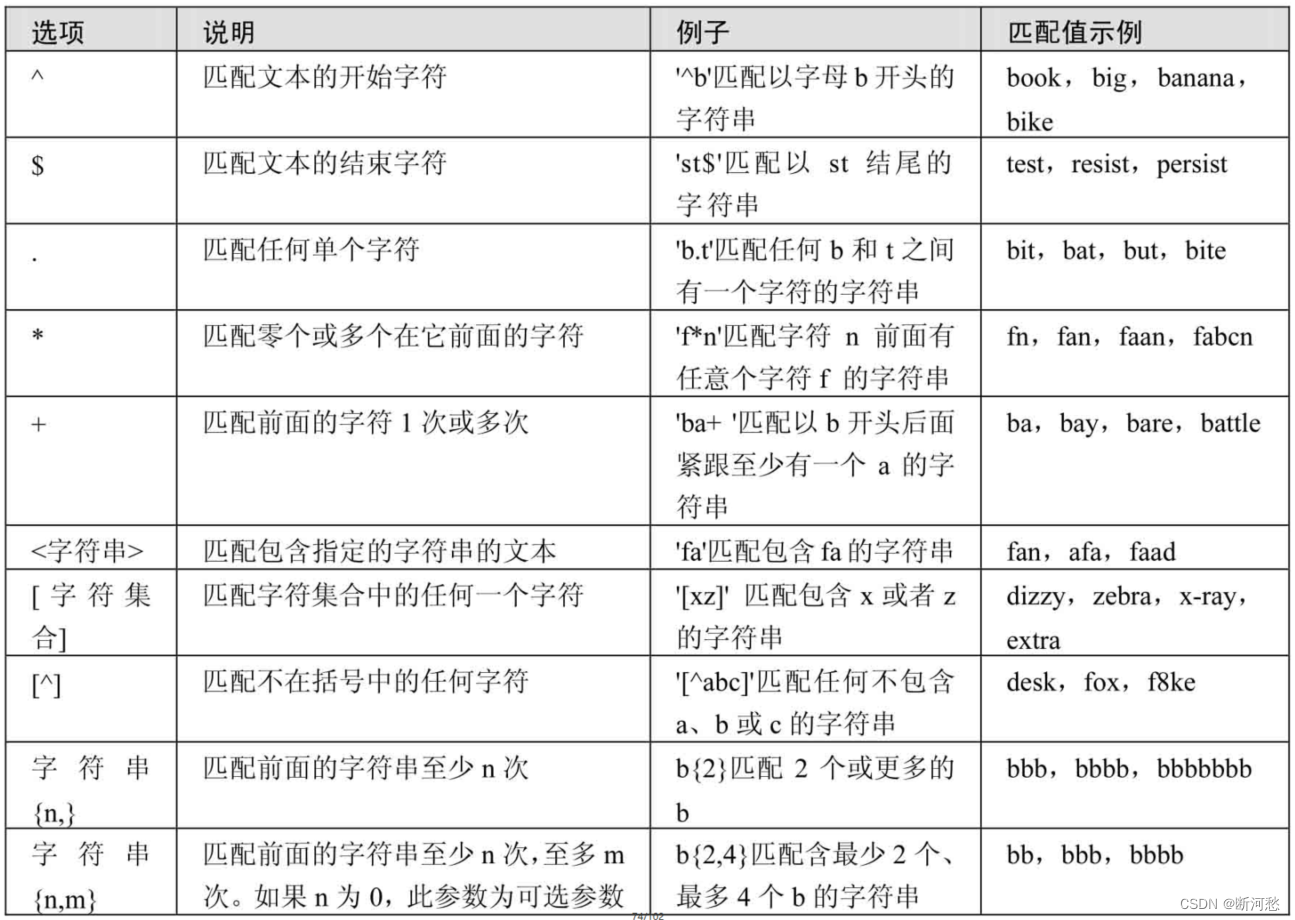前言
这篇博客继承前篇博客的内容,将对张量的操作进行阐述,同时在理解张量的一些数学的基础上,配合机器学习的理论,在pytorch环境中进行一元线性回归模型的构建。
张量的拼接与切分
torch.cat()
功能:将张量按维度dim进行拼接
torch.stack()
功能:在新创建的维度dim上进行拼接
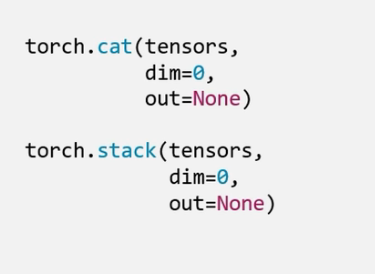
- tensors:张量序列
- dim:要拼接的维度
import torch
a = torch.ones((2,3))
# 张量的拼接
a1 = torch.cat([a,a],dim=0)
print(a)
print(a1)
输出:
tensor([[1., 1., 1.],
[1., 1., 1.]])
tensor([[1., 1., 1.],
[1., 1., 1.],
[1., 1., 1.],
[1., 1., 1.]])
dim=1
a2 = torch.cat([a,a],dim=1)
print(a2)
tensor([[1., 1., 1., 1., 1., 1.],
[1., 1., 1., 1., 1., 1.]])
stack:
import torch
a = torch.ones((2,3))
a1 = torch.stack([a,a],dim=2)
print(a1)
输出:
tensor([[[1., 1.],
[1., 1.],
[1., 1.]],
[[1., 1.],
[1., 1.],
[1., 1.]]])
torch.chunk()
功能:将张量按维度dim进行平均切分
返回值:张量列表
注意事项:若不能整除,最后一份张量小于其他张量
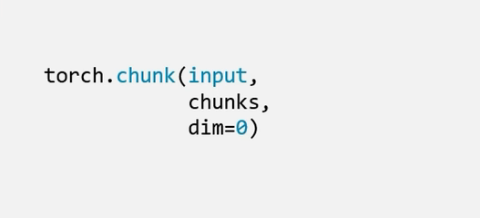
- input:要切分的张量
- chunks:要切分的份数
- dim:要切分的维度
b = torch.ones((2,5))
print(b)
b1 = torch.chunk(b,dim=1,chunks=2)
print(b1)
输出:
tensor([[1., 1., 1., 1., 1.],
[1., 1., 1., 1., 1.]])
(tensor([[1., 1., 1.],
[1., 1., 1.]]), tensor([[1., 1.],
[1., 1.]]))
torch.split()
功能:将张量按维度dim进行切分
返回值:张量列表
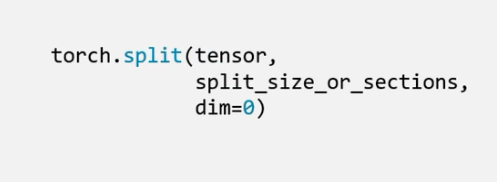
- tensor:要切分的张量
- split_size_or_setions:为int时,表示每一份的长度;为list时,按lisr元素切分
- dim:要切分的维度
c = torch.ones((2,5))
c1 = torch.split(c,2,dim=1)
print(c1)
(tensor([[1., 1.],
[1., 1.]]), tensor([[1., 1.],
[1., 1.]]), tensor([[1.],
[1.]]))
采用list:
c = torch.ones((2,5))
c1 = torch.split(c,[2,1,2],dim=1)
# print(c1)
for i in c1:
print(i)
tensor([[1., 1.],
[1., 1.]])
tensor([[1.],
[1.]])
tensor([[1., 1.],
[1., 1.]])
注意:
list中所有的元素加起来需要等于指定维度上的张量的长度。
张量的索引
torch.index_select()
功能:在维度dim上,按index索引数据
返回值:依index索引数据拼接的张量
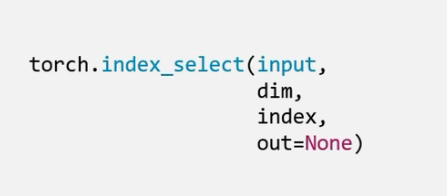
- input:要索引的张量
- dim:要索引的维度
- index:要索引数据的序号
d = torch.randint(0,9,size=(3,3))
idx = torch.tensor([0,2],dtype=torch.long)
d1 = torch.index_select(d,dim=0,index=idx)
print(d)
print(idx)
print(d1)
输出:
tensor([[5, 0, 3],
[1, 0, 3],
[0, 8, 2]])
tensor([0, 2])
tensor([[5, 0, 3],
[0, 8, 2]])
注意:
index的值需要是一个张量 而且dtype也必须是torch.long
torch.masked_select()
功能:按mask中的True进行索引
返回值:一维张量
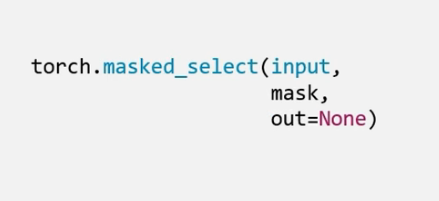
- input:要索引的张量
- mask:与input同形状的布尔类型张量
t = torch.randint(0,9,size=(3,3))
mask = t.ge(5)
print(t)
print(mask)
ge(x)方法的使用:
当张量中的元素>=x的时候就会变True,剩余情况则为False,该例子中x是5.
t和mask的值:(每次都会变)
tensor([[0, 3, 6],
[7, 5, 8],
[2, 8, 0]])
tensor([[False, False, True],
[ True, True, True],
[False, True, False]])
使用masked_select()方法进行布尔值为True的元素索引
t = torch.randint(0,9,size=(3,3))
mask = t.ge(5)
print(t)
print(mask)
t1 = torch.masked_select(t,mask=mask)
print(t1)
输出:
tensor([[8, 8, 4],
[1, 4, 7],
[6, 4, 5]])
tensor([[ True, True, False],
[False, False, True],
[ True, False, True]])
tensor([8, 8, 7, 6, 5])
张量变换
torch.reshape()
功能:变换张量的形状
注意事项:当张量在内存中是连续时,新张量与input共享数据内存

- input:要变换的张量
- shape:新张量的形状
t = torch.ones(8)
t_reshape = torch.reshape(t,(2,4))
print(t)
print(t_reshape)
输出:
tensor([1., 1., 1., 1., 1., 1., 1., 1.])
tensor([[1., 1., 1., 1.],
[1., 1., 1., 1.]])
如果把原始张量的第一个元素改为2
t[0] = 2
print(t_reshape)
tensor([[2., 1., 1., 1.],
[1., 1., 1., 1.]])
会发现改变过形状的张量的第一个元素也会改变,说明新张量与input共享数据内存。
注:共享数据内存不代表,它们在同一个内存地址,而是代表它们所指向的内存空间是一样的。
print(id(t),id(t_reshape)) # 2081724628720 2081889008512
print(id(t.data),id(t_reshape.data)) # 1370880600800 1370880600800
torch.transpose()
功能:交换张量的两个维度
torch.t()
功能:2维张量转置,对矩阵而言,等价于torch.transpose(input,0,1)
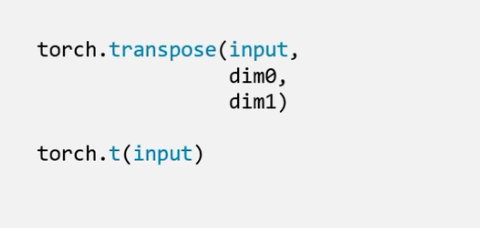
- input:要交换的张量
- dim0:要交换的维度
- dim1:要交换的维度
t = torch.rand(size=(2,3,4))
print(t)
t1 = torch.transpose(t,0,1)
print(t1)
tensor([[[0.6628, 0.1919, 0.1204, 0.3246],
[0.0973, 0.0540, 0.3222, 0.4540],
[0.2753, 0.3575, 0.4117, 0.2105]],
[[0.0800, 0.7416, 0.3095, 0.6480],
[0.9503, 0.8973, 0.0828, 0.2698],
[0.6524, 0.1959, 0.3461, 0.8498]]])
tensor([[[0.6628, 0.1919, 0.1204, 0.3246],
[0.0800, 0.7416, 0.3095, 0.6480]],
[[0.0973, 0.0540, 0.3222, 0.4540],
[0.9503, 0.8973, 0.0828, 0.2698]],
[[0.2753, 0.3575, 0.4117, 0.2105],
[0.6524, 0.1959, 0.3461, 0.8498]]])
Process finished with exit code 0
torch.squeeze()
功能:压缩维长度为1的维度(轴)
- dim:若为None,移出所有长度为1 的轴;若指定维度,当且仅当该轴长度为1时,可以被移除;
torch.unsqueeze()
功能:依据dim扩展维度
- dim:扩展的维度
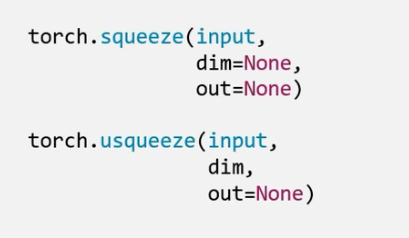
t = torch.rand((1,2,3,1))
print(t.shape)
t1 = torch.squeeze(t)
print(t1.shape)
输出:
torch.Size([1, 2, 3, 1])
torch.Size([2, 3])
如果指定了dim参数:
t = torch.rand((1,2,3,1))
print(t.shape)
t1 = torch.squeeze(t,dim=0)
print(t1.shape)
输出:
torch.Size([1, 2, 3, 1])
torch.Size([2, 3, 1])
就只会压缩第四维度的轴。
张量的数学运算
pytorch中提供了丰富的张量数学运算
1、加减乘除
- torch.add()
- torch.addcdiv()
- torch.addcmul()
- torch.sub()
- torch.div()
- torch.mul()
2、对数,指数,幂函数
- torch.log(input,out=None)
- torch.log10(input,out=None)
- torch.log2(input,out=None)
- torch.exp(input,out=None)
- torch.pow()
3、三角函数
- torch.abs(input,out=None)
- torch.acos(input,out=None)
- torch.cosh(input,out=None)
- torch.cos(input,out=None)
- torch.asin(input,out=None)
- torch.atan(input,out=None)
- torch.atan2(input,out=None)
torch.add()
功能:逐元素计算 input + alpha x other
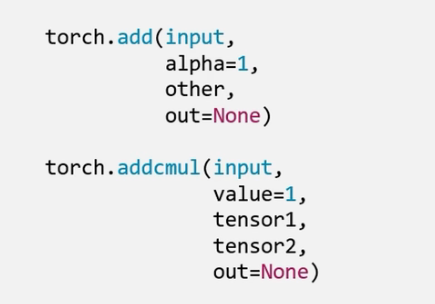
- input:第一个张量
- alpha:乘项因子
- other:第二个张量
add()方法不仅仅可以做加法运算,还可以做线性运算
- 机器学习中的公式:
y = wx + b
import torch
# torch.add()
t = torch.rand((3,3))
t1 = torch.rand((3,3))
print("t",t)
print("t1",t1)
t2 = torch.add(t,t1)
t3 = torch.add(t,t1,alpha=2)
print("t2",t2)
print("t3",t3)
输出:
t tensor([[0.8218, 0.8576, 0.4829],
[0.6046, 0.1290, 0.4835],
[0.5752, 0.2386, 0.1260]])
t1 tensor([[0.5306, 0.7424, 0.4328],
[0.3278, 0.1980, 0.4354],
[0.4742, 0.4319, 0.8922]])
t2 tensor([[1.3524, 1.6000, 0.9157],
[0.9324, 0.3270, 0.9189],
[1.0494, 0.6705, 1.0182]])
t3 tensor([[1.8830, 2.3423, 1.3484],
[1.2602, 0.5249, 1.3544],
[1.5236, 1.1024, 1.9104]])
线性回归
线性回归时分析一个变量与另外一(多)个变量之间关系的 方法
因变量:y
自变量:x
关系:线性
y = wx + b
分析:求解w,b
求解步骤:
1、确定模型
Model: y = wx + b
2、选择损失函数
MSE: 均方差
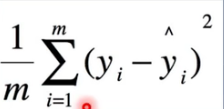
3、求解梯度并更新w,b
w = w - LRw.grad
b = b - LRw.grad
pytorch中实现一元线性回归模型
# 一元线性回归
import torch
import matplotlib.pyplot as plt
torch.manual_seed(10)
lr = 0.1 #学习率/步长
# 创建训练数据
x = torch.rand(20,1) * 10
y = 2*x + (5 + torch.randn(20,1))
# 构建线性回归参数
w = torch.randn((1),requires_grad=True) # 允许更新梯度
b = torch.zeros((1),requires_grad=True)
for iteration in range(1000):
# 前向传播
wx = torch.mul(w,x)
y_pred = torch.add(wx,b)
# 计算MSE loss
loss = (0.5*(y-y_pred)**2).mean()
# 反向传播
loss.backward()
# 更新参数
w.data.sub_(lr * w.grad)
b.data.sub_(lr * b.grad)
if iteration % 20 == 0:
plt.scatter(x.data.numpy(),y.data.numpy())
plt.plot(x.data.numpy(),y_pred.data.numpy(),'r-',lw=5)
plt.text(2,20,'Loss=%.4f' % loss.data.numpy())
plt.xlim(1.5,10)
plt.ylim(8,28)
plt.title("huiguimoxing interation={}".format(iteration))
plt.pause(0.5)
plt.show()
if loss.data.numpy() < 1:
break
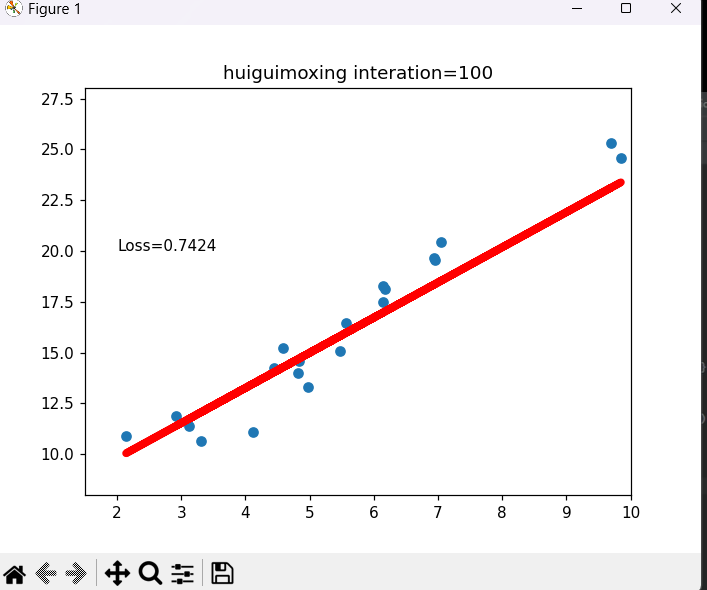
当迭代到100次时loss已经接近0了 此时该线性的图也接近这些这些数据。






